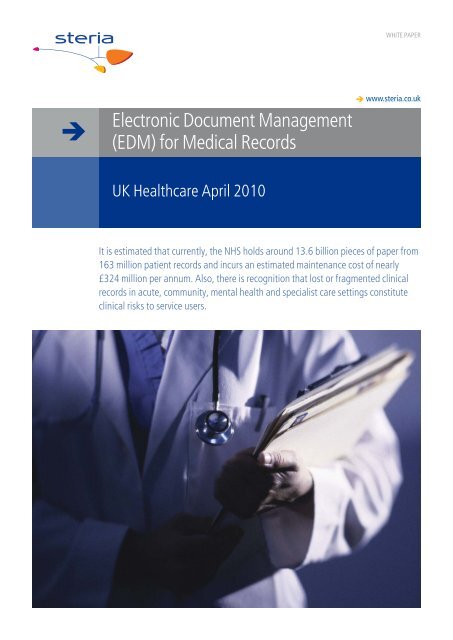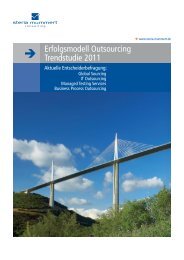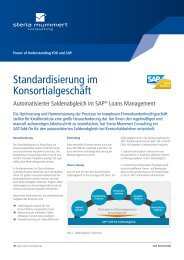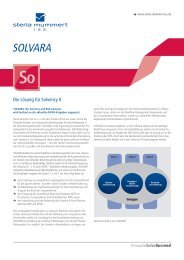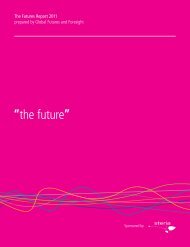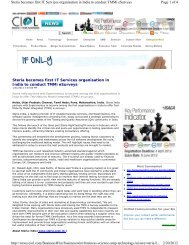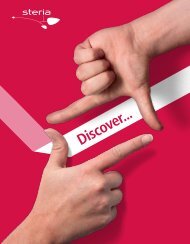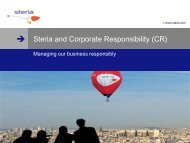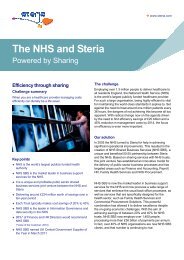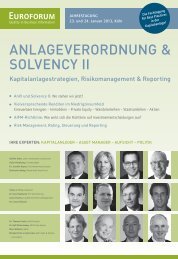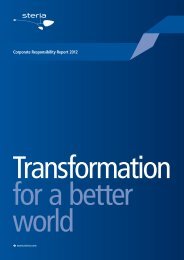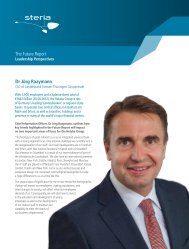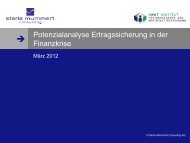Electronic document management (EDM) for medical records - Steria
Electronic document management (EDM) for medical records - Steria
Electronic document management (EDM) for medical records - Steria
You also want an ePaper? Increase the reach of your titles
YUMPU automatically turns print PDFs into web optimized ePapers that Google loves.
WHITE PAPER<br />
Ë<br />
<strong>Electronic</strong> Document Management<br />
(<strong>EDM</strong>) <strong>for</strong> Medical Records<br />
UK Healthcare April 2010<br />
It is estimated that currently, the NHS holds around 13.6 billion pieces of paper from<br />
163 million patient <strong>records</strong> and incurs an estimated maintenance cost of nearly<br />
£324 million per annum. Also, there is recognition that lost or fragmented clinical<br />
<strong>records</strong> in acute, community, mental health and specialist care settings constitute<br />
clinical risks to service users.
<strong>Electronic</strong> Document Management (<strong>EDM</strong>) <strong>for</strong> Medical Records<br />
Introduction<br />
Trusts recognise that access to <strong>document</strong>s, including access to<br />
patient health <strong>records</strong> at the point of care, is critical to ensure:<br />
Ë Provision of high quality and efficient patient care (improved<br />
patient care);<br />
Ë Implementation of improved service delivery models;<br />
Ë Delivery of Trust improvements including redevelopment and<br />
service modernisation plans;<br />
Ë Con<strong>for</strong>mance with the standards of the Clinical Negligence<br />
Scheme <strong>for</strong> Trusts (CNST) – now NHSLA.<br />
This focus is consistent with the key objective of the NHS IT strategy,<br />
‘Delivering 21st Century Support <strong>for</strong> the NHS’ where:<br />
Records about a patient and his/her care are held electronically and<br />
are accessible by all who need them, including the patient themselves,<br />
within any care location at any time.<br />
One method of overcoming such issues is the implementation of an<br />
<strong>Electronic</strong> Document Management (<strong>EDM</strong>) system which captures<br />
images of paper <strong>medical</strong> <strong>records</strong> and presents these securely and<br />
reliably to <strong>medical</strong> and clinical staff via a PC or hand-held option<br />
such as a tablet device.<br />
The implementation of <strong>EDM</strong> supports the following key national<br />
business drivers:<br />
Ë Quality improvement and reduction in errors;<br />
Ë Improvement in efficiency;<br />
Ë Development of staff;<br />
Ë Open access to in<strong>for</strong>mation;<br />
Ë Delivering the NHS plan;<br />
Ë In<strong>for</strong>mation <strong>for</strong> health;<br />
Ë Delivering 21st century IT support <strong>for</strong> the NHS;<br />
Ë Clinical governance;<br />
Ë Clinical Negligence Scheme <strong>for</strong> Trusts (CNST, now NHSLA).<br />
Issues driving the need <strong>for</strong> change<br />
Trusts experience a variety of pressures which drive them towards an<br />
urgent need to digitise their <strong>medical</strong> <strong>records</strong> libraries. Issues include:<br />
Storage<br />
Ë Lack of storage space – some Trusts have calculated their shelf<br />
space <strong>for</strong> storing <strong>medical</strong> <strong>records</strong> to be in the 5km to 10km range;<br />
an enormous drain on estate resources;<br />
Ë Duplication and fragmentation of files in several locations and<br />
between clinical staff results in files not being available or “lost”;<br />
Ë Increasing size of the health record folder adds to the storage<br />
pressures.<br />
Financial<br />
Ë High cost of filing and administering patients <strong>records</strong>;<br />
Ë High costs of retrieving and delivering patients <strong>records</strong> to clinics;<br />
Ë Cost of culling and destruction of patient <strong>records</strong>;<br />
Ë Cost of <strong>medical</strong> negligence claims if proper treatment cannot be<br />
substantiated by the <strong>medical</strong> record, if it is misplaced.<br />
Security and audit<br />
Ë Security of patients’ <strong>records</strong> as they are transported across sites;<br />
Ë Difficulty in controlling or auditing access to patients’ <strong>records</strong>;<br />
Ë Difficulty in locating files required <strong>for</strong> clinical, legal, insurance and<br />
Data Protection Authority purposes;<br />
Ë Improvement to clinical and in<strong>for</strong>mation governance;<br />
Ë Health & Safety issues in storage areas, as well as in the handling<br />
of patients <strong>records</strong> in clinical areas.<br />
Clinical<br />
Ë Reduction of clinical risks;<br />
Ë Better <strong>management</strong> of patient journey;<br />
Ë Improvement to patient experience;<br />
Ë Knowledge and in<strong>for</strong>mation <strong>management</strong> <strong>for</strong> greater<br />
clinical efficiency.<br />
2
<strong>Electronic</strong> Document Management (<strong>EDM</strong>) <strong>for</strong> Medical Records<br />
Proposition <strong>for</strong> an <strong>EDM</strong> shared service<br />
The provision of this service is a key progression of the NHS’s shared<br />
business strategy <strong>for</strong> health since shared services already achieve<br />
significant savings to the NHS, through initiatives such as:<br />
1. NHS Shared Business Services (NHS SBS), a joint venture with the<br />
NHS, whereby finance & accounting, HR and payroll services are<br />
delivered to some 130 Trusts across England;<br />
2. The Department of Health and Directgov websites run on shared<br />
enterprise strength plat<strong>for</strong>ms, providing services to the NHS and to<br />
citizens. Managed through “The Club” robust and resilient web<br />
services are delivered by <strong>Steria</strong> with ongoing development and<br />
service support available to the organisations utilising the shared<br />
plat<strong>for</strong>ms, resources and hosting Services;<br />
3. NHS supply chain, as such, a highly efficient way <strong>for</strong>ward is to<br />
develop a shared <strong>Electronic</strong> Document Management System<br />
(<strong>EDM</strong>S) service <strong>for</strong> <strong>medical</strong> <strong>records</strong> based on a shared plat<strong>for</strong>m.<br />
A supplier should be willing to invest significantly with the<br />
guidance and partnership of Trusts in ensuring the scanning and<br />
<strong>EDM</strong>S facilities are attuned to NHS requirements in general - and<br />
the clinical needs of staff and patients in particular.<br />
By being at the vanguard of such a service, Trusts would capitalise on<br />
the benefits of:<br />
Ë Ensuring the shared service is fully tailored to their requirements<br />
without compromise. (Some tailoring is essential to ensure ease of<br />
use of such a product in a demanding clinical environment);<br />
Ë Experiencing year on year service cost reductions as additional<br />
Trusts join the service;<br />
Ë Working with a supplier whose ambitions in this <strong>medical</strong> <strong>records</strong><br />
<strong>EDM</strong> market place ensure that the service will be resourced <strong>for</strong><br />
unfailing success;<br />
Ë Having the service delivered from an even more robust plat<strong>for</strong>m<br />
than one Trust might be able to justify;<br />
Ë Receiving functionality improvements funded via additional<br />
requirements contracted by subsequent Trusts.<br />
It is important that a detailed product analysis is undertaken utilising<br />
a depth of skills across a range of products and that functionality is<br />
compared alongside Total Cost of Ownership (TCO) of both project<br />
delivery as well as on-going service provision. Several products<br />
purport to provide the required functionality but don’t unless used in<br />
conjunction with other add-on products, while other products provide<br />
all the functionality but at a high cost. Particular care needs to be<br />
exerted in the effects of volumetrics (users and scan pages) as the<br />
volumes involved in any <strong>medical</strong> <strong>records</strong> application are very<br />
significant.<br />
Technically, such a solution must be designed around a highly<br />
scalable, cost-effective and market leading product together with<br />
innovative scanning and image <strong>management</strong> software. The solution<br />
needs to be tailored to enable images to be identified and restructured<br />
into a consistent <strong>medical</strong> record, in accordance with the<br />
Royal College of Physicians’ current developing guidelines.<br />
A product such as EMC’s Documentum has been implemented in both<br />
acute Trusts and PCTs. As a result, the shared plat<strong>for</strong>m is a very low<br />
business risk since the software product has been successfully tested<br />
in environments attractive to over 300 Trusts, which demonstrates<br />
that the business case is solid.<br />
This also means that a Trust must ensure that they focus on<br />
addressing the key business issues around scanning and delivering<br />
electronic <strong>medical</strong> <strong>records</strong>, rather than merely procuring a hardware<br />
and software solution.<br />
As such, a highly efficient way <strong>for</strong>ward is to develop a shared <strong>Electronic</strong> Document<br />
Management System (<strong>EDM</strong>S) service <strong>for</strong> <strong>medical</strong> <strong>records</strong> based on a shared plat<strong>for</strong>m.<br />
A supplier should be willing to invest significantly with the guidance and partnership<br />
of Trusts in ensuring the scanning and <strong>EDM</strong>S facilities are attuned to NHS<br />
requirements in general - and the clinical needs of staff and patients in particular.<br />
3
<strong>Electronic</strong> Document Management (<strong>EDM</strong>) <strong>for</strong> Medical Records<br />
The Governance of the project, manifested in a Joint Development Board, enshrines<br />
the Trust’s control of business function direction and will provide technical and<br />
commercial input based on experience, to build a quality service <strong>for</strong><br />
the Trust.<br />
Solution implementation approach<br />
An approach to implementation should be collaborative, in a true<br />
partnership framework. The Governance of the project, manifested in<br />
a Joint Development Board, enshrines the Trust’s control of business<br />
function direction and will provide technical and commercial input<br />
based on experience, to build a quality service <strong>for</strong> the Trust.<br />
Embracing the Trust’s approach to implementation, the supplier must<br />
build a cost structure <strong>for</strong> the implementation around that approach<br />
and undertake detailed planning on that basis. A joint Project<br />
Initiation Document (PID) would <strong>document</strong> and be the benchmark by<br />
which that approach would be managed and monitored.<br />
A few examples of this type of approach to collaboration include:<br />
Ë Convening a joint development board to oversee strategic<br />
direction and approach;<br />
Ë Running a joint selection “beauty parade” on scanning equipment<br />
to ensure specific case notes are processed with a minimum of<br />
manual intervention to reduce on-going scan manpower costs;<br />
Ë Implementing a Proof of Concept in conjunction with the Trust<br />
and the Royal College of Physicians to show how the Trust’s<br />
specific case notes can be auto-restructured to meet emerging<br />
standards;<br />
Ë Participating in a change <strong>management</strong> programme with the Trust<br />
to ensure this rapid advance to a paperless environment is fully<br />
adopted by staff;<br />
Ë Participating with the Trust in the further exploitation of <strong>EDM</strong><br />
through the product’s workflow and integration capabilities.<br />
Solution outline<br />
An <strong>EDM</strong> solution provides:<br />
Ë An in-hospital scanning “implant” service staffed by supplier<br />
staff working closely with Trust staff. In-house scanning is<br />
important as the difficulties and costs in retrieving case notes<br />
urgently when they are taken off-site <strong>for</strong> scanning should not be<br />
under-estimated. The use of supplier staff is important as there is<br />
an initial upsurge in activity while the switch-over takes place,<br />
and in the meantime a <strong>medical</strong> <strong>records</strong> function must continue<br />
to be delivered;<br />
Ë Options <strong>for</strong> scanning either active <strong>medical</strong> <strong>records</strong> only, or active<br />
plus dormant <strong>medical</strong> <strong>records</strong>, should be considered. Active record<br />
scanning may also include “scan-on-demand”, but this approach<br />
- while it may involve a somewhat lower volume scanning function<br />
than full active record scanning - never gets to the end of the high<br />
volume scanning workload;<br />
Ë Scanning software must provide high accuracy scanning together<br />
with facilities <strong>for</strong> reliable <strong>document</strong> recognition to help with restructuring<br />
<strong>medical</strong> <strong>records</strong>, to minimise the time being spent on<br />
manual ef<strong>for</strong>t;<br />
Ë Scanning software configuration is required to provide automated<br />
<strong>document</strong> recognition <strong>for</strong> <strong>medical</strong> <strong>records</strong> categorisation. This<br />
enables automated re-structuring of misfiled pages in case notes,<br />
or more far-reaching re-structuring to meet the Royal College of<br />
Physicians best practice guidance on <strong>medical</strong> <strong>records</strong> structure,<br />
which is currently being developed;<br />
Ë Scanning hardware must be selected and there is a strong case <strong>for</strong><br />
trialling such hardware on each Trust’s <strong>records</strong> as the quality of<br />
case notes is variable. Final determination should be undertaken<br />
as a trial period on actual <strong>medical</strong> <strong>records</strong>;<br />
Ë <strong>EDM</strong> software from a leading, specialist supplier <strong>for</strong> <strong>medical</strong><br />
<strong>records</strong> is important as such software will fully meet the<br />
requirements set out by Trusts in a cost effective way. This should<br />
be configured by the supplier to provide a look and feel on-screen<br />
browse experience akin to browsing the paper record, in order to<br />
minimise training time and costs <strong>for</strong> <strong>medical</strong> staff;<br />
Ë Integration with PAS, RIS, LIMS and a number of additional<br />
systems <strong>for</strong> the purpose of capturing, at source, ongoing <strong>medical</strong><br />
record related in<strong>for</strong>mation. In this respect, <strong>EDM</strong> can provide the<br />
results reporting end of order communications;<br />
Ë A managed service option allowing <strong>for</strong> the servers to be hosted in<br />
an “industrial strength” datacentre, with high capacity, secure<br />
and advanced data storage facilities. This will provide higher levels<br />
of “admissibility-in-evidence” assurance, with second centre<br />
disaster recovery fail-over facilities, together with 24 x 365<br />
operations cover and SLA guarantees. This in itself is a strong<br />
indication that a shared service is optimal as many Trusts cannot<br />
af<strong>for</strong>d or justify such a contingency capability on their own.<br />
4
<strong>Electronic</strong> Document Management (<strong>EDM</strong>) <strong>for</strong> Medical Records<br />
Benefits of the solution to the Trust<br />
The solution brings the benefits of:<br />
Ë <strong>Electronic</strong> Health Records (EHRs) removing the need <strong>for</strong> up to<br />
1,000 paper-based case notes to be delivered each day across a<br />
hospital’s multiple sites;<br />
Ë Over £2.5 million per annum per Trust in paper handling and other<br />
costs is expected to be saved <strong>for</strong> an annual investment of around<br />
£1.5 million – with a pay back of under 2 years;<br />
Ë Major quality improvements to the way that the business service is<br />
delivered in a location independent approach;<br />
Ë Multi-user simultaneous access to case notes allowing true shared<br />
care <strong>for</strong> patients and better <strong>medical</strong> outcomes;<br />
Ë 100% availability of case notes (at present we estimate around<br />
20% are not available when needed because someone else has<br />
them or they are temporarily lost) there<strong>for</strong>e better clinical<br />
judgements are enabled;<br />
Ë Reduction in wasted time of both clinical staff and patients when<br />
they arrive <strong>for</strong> appointments and notes are not available. Also, as<br />
a by-product, safeguarding the Trust’s “green” status under<br />
Monitor’s compliance regime by helping to meet the national 18<br />
week to treatment target;<br />
Ë Assured automation of aspects of clinical pathways are enabled<br />
through the workflow capabilities built into the <strong>EDM</strong> (e.g. <strong>EDM</strong><br />
provides another option <strong>for</strong> fast discharge summaries to be<br />
produced, authorised and transmitted electronically);<br />
Ë Risk reduction and increased security through the elimination of<br />
fire and flood concerns. A feature of the shear weight of <strong>medical</strong><br />
<strong>records</strong> means that many Trusts store their <strong>records</strong> in the<br />
basement where they are at risk from water damage either<br />
through storm overflow or plumbing incidents;<br />
Ë Reductions in litigation risk: With the compensation culture of<br />
today, successful claims can seriously drain a Trust’s resources.<br />
Consequently Trusts need to rely on improved security of<br />
<strong>document</strong>ation and easy but controlled access to their<br />
in<strong>for</strong>mation;<br />
Ë Possibilities <strong>for</strong> further automation of pathways through<br />
partnership with a supplier organisation bringing extensive skills<br />
in large scale, secure <strong>EDM</strong> implementations - and an organisation<br />
with proven experience in partnering with the NHS <strong>for</strong> the<br />
development and roll-out of cost-effective services.<br />
5
<strong>Electronic</strong> Document Management (<strong>EDM</strong>) <strong>for</strong> Medical Records<br />
<strong>Steria</strong><br />
<strong>Steria</strong>, as a major European IT led business services company,<br />
is uniquely capable of fulfilling all <strong>EDM</strong> requirements <strong>for</strong> <strong>medical</strong><br />
<strong>records</strong> including the provision of a managed service around both the<br />
IT functions and the scanning services. <strong>Steria</strong>’s uniqueness stems from:<br />
Ë Our partnership with EMC, utilising the UK’s leading <strong>medical</strong><br />
<strong>records</strong> <strong>EDM</strong> system called Documentum to ensure the Trust<br />
requirements are fully met;<br />
Ë Our ability to <strong>for</strong>m long term, mutually beneficial partnerships,<br />
proof of which is the finance & accounting services delivered to<br />
around 130 Trusts through our award winning joint venture with<br />
the Department of Health, called NHS Shared Business Services.<br />
NHS SBS was cited in the recent Operational Efficiency Programme<br />
as an example of best practice in the provision of back office<br />
services to the public sector;<br />
Ë Our willingness to be flexible in the partnership, i.e. to take on<br />
business processes (e.g. scanning) as well as deliver technology<br />
plat<strong>for</strong>ms; to transfer staff under TUPE, if appropriate; to introduce<br />
innovation to both the technology arrangements as well as the<br />
commercial arrangements;<br />
Ë Our experience in developing and successfully rolling out major<br />
NHS projects such as the “Spine” equivalent project (the HCN<br />
project) we undertook in Northern Ireland and now operate as a<br />
managed service;<br />
Ë Our ability to develop and operate robust, secure, cost-saving,<br />
shared service plat<strong>for</strong>ms.<br />
Our preference is to provide the scanning service as an “implant”<br />
within the Trust’s premises as that approach obviates the high risks<br />
associated with transporting <strong>medical</strong> <strong>records</strong> around the country.<br />
We have implemented major <strong>EDM</strong>S functions in extremely large<br />
government departments - such as the 20,000 user <strong>records</strong> project in<br />
Northern Ireland, and the secure Documentum system <strong>for</strong> a large city<br />
police <strong>for</strong>ce - and have a high skill level of staff experienced in<br />
implementing health systems within both acute and primary care<br />
Trusts. We also deliver large capacity scanning capability to the NHS,<br />
the Identity & Passport Service, the UK's leading pharmacy-led health<br />
and beauty retailer and several other well known high street<br />
organisations.<br />
We have implemented major <strong>EDM</strong>S functions in extremely large government<br />
departments - such as the 20,000 user <strong>records</strong> project in Northern Ireland, and the<br />
secure Documentum system <strong>for</strong> a large city police <strong>for</strong>ce - and have a high skill level<br />
of staff experienced in implementing health systems within both acute and primary<br />
care Trusts.<br />
6
<strong>Electronic</strong> Document Management (<strong>EDM</strong>) <strong>for</strong> Medical Records<br />
Conclusion<br />
By utilising a market leading <strong>EDM</strong> product - tailored by <strong>Steria</strong>’s highly<br />
experienced <strong>EDM</strong> specialists to meet specific Trust requirements - the<br />
Trust can be assured that technology risk is eliminated and user<br />
acceptance is maximised.<br />
<strong>Steria</strong> has designed end-to-end processes and technical capabilities<br />
which dovetail into existing <strong>medical</strong> <strong>records</strong> practices, replacing the<br />
manual delivery processes with rapid electronic availability of those<br />
<strong>records</strong>. We are seeking true partners with whom we can undertake<br />
the implementation and deployment work and with whom we<br />
can jointly base our solution <strong>for</strong> the future to deliver high quality,<br />
cost-effective <strong>medical</strong> <strong>records</strong> across numerous Trusts.<br />
By having the option of participating in the foundation of an<br />
innovative shared service alongside an organisation like <strong>Steria</strong>, which<br />
is experienced in delivering such shared services, the Trust can be sure<br />
they will gain all the advantages of cost reductions brought about<br />
through service sharing. This represents a win-win situation <strong>for</strong> the<br />
Trust and <strong>for</strong> <strong>Steria</strong> - and a true partnership <strong>for</strong> the future.<br />
7
About <strong>Steria</strong><br />
<strong>Steria</strong> delivers IT enabled business services which help<br />
organisations in the public and private sectors operate<br />
more efficiently and profitably. By combining in depth<br />
understanding of our clients’ businesses<br />
with expertise in IT and business process outsourcing,<br />
we take on our clients’ challenges and develop<br />
innovative solutions to address them. Through our<br />
highly collaborative consulting style, we work with our<br />
clients to trans<strong>for</strong>m their business, enabling them to<br />
focus on what they do best. Our 18,300 people, working<br />
across 16 countries, support the systems, services and<br />
processes that make today’s world turn, touching the<br />
lives of millions around the globe each day.<br />
Founded in 1969, <strong>Steria</strong> has offices in Europe, India,<br />
North Africa and SE Asia and a 2009 revenue of<br />
e1.63 billion. 19.3% of <strong>Steria</strong>’s capital is owned by its<br />
employees. Headquartered in Paris, <strong>Steria</strong> is listed on<br />
the Euronext Paris market.<br />
contact<br />
<strong>Steria</strong> Limited, Three Cherry Trees Lane, Hemel Hempstead,<br />
Hert<strong>for</strong>dshire, HP2 7AH<br />
Tel. +44 (0)845 601 8877<br />
www.steria.co.uk<br />
For more in<strong>for</strong>mation contact Keith Irvine on Tel. +44(0) 7966 824912<br />
or email: keith.irvine@steria.co.uk<br />
© <strong>Steria</strong> st052uk / April 2010


